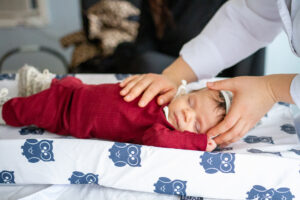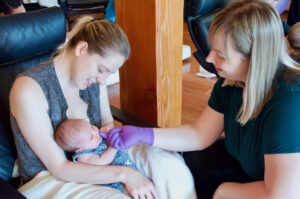Belly buttons can come in all sorts of shapes and depths, but are generally divided into two categories: innies and outies. While innie belly buttons are flat or hollowed, outie belly buttons protrude to some degree.
But the differences between innies and outies goes beyond simple aesthetics, at least for newborns. For very young babies, having an outie belly button is specifically associated with a variety of symptoms that can include trouble burping, latching issues, reflux issues, frequent spit-ups, straining to poop, and persistent fussiness. Babies with outie belly buttons may grunt a lot, especially when they have been put down to sleep on their backs. They may do “baby crunches,” trying to sit up repeatedly at a very young age. Their outie may pop out further when they struggle to pass gas. And they may have a very obvious preference for lying on one side over the other.
Why do babies with outie belly buttons display so many symptoms? It may have to do with tension stemming from the length of their umbilical cord or its placement during birth. Babies whose umbilical cords were either short or wrapped around their neck or body during birth often have outies.
The umbilical cord was once part of the belly button, which is clinically known as the umbilicus. Within the umbilicus are two umbilical arteries and an umbilical vein which carries oxygenated blood from the placenta to the fetus, travelling along the falciform ligament (a fibrous tissue that connects the liver to the front body wall and separates its left lobe into two sections) within the body of the fetus. The vein empties this oxygen-rich blood into the fetal circulatory system. After birth, the umbilical arteries and umbilical vein close up, as the lungs take over the job of delivering oxygen to the newborn baby.
I have my own theory regarding the symptoms associated with outie belly buttons. I believe that short or wrapped umbilical cords create tension and recurrent pulling on the falciform ligament. This tension may keep the baby’s rectus abdominis muscles separated more than they need to be in order to allow the umbilical vein and arteries entry. The falciform ligament being pulled or stretched to the right of the abdomen can lead to an umbilical hernia… which resembles an outie belly button. This theory explains each of the symptoms listed above, as the baby struggles to deal with abdominal tightness and their flexing leads to a lack of space in their abdominal cavity.
No matter the underlying cause of the symptoms associated with outie belly buttons, these little ones feel discomfort and tension — and although many doctors prefer to take a wait-and-see approach, I believe that CST is an ideal therapy for treating them. Through CST, we are able to find and release the tension along the falciform ligament, relaxing the fascia around the belly button. This also reduces strain on the nearby pyloric valve (which allows food to pass into the small intestine from the stomach), making it easier for milk to move through the baby’s body and reducing the frequency of spit-ups!
The next time you hear someone say that there’s no real difference between an innie and an outie, you can set them straight — and give them a bonus anatomy lesson.
Are you interested in incorporating CST into your own practice? Register for my virtual Infant Craniosacral Therapy Level 1 Part 1 course to learn more about this powerful healing modality.






